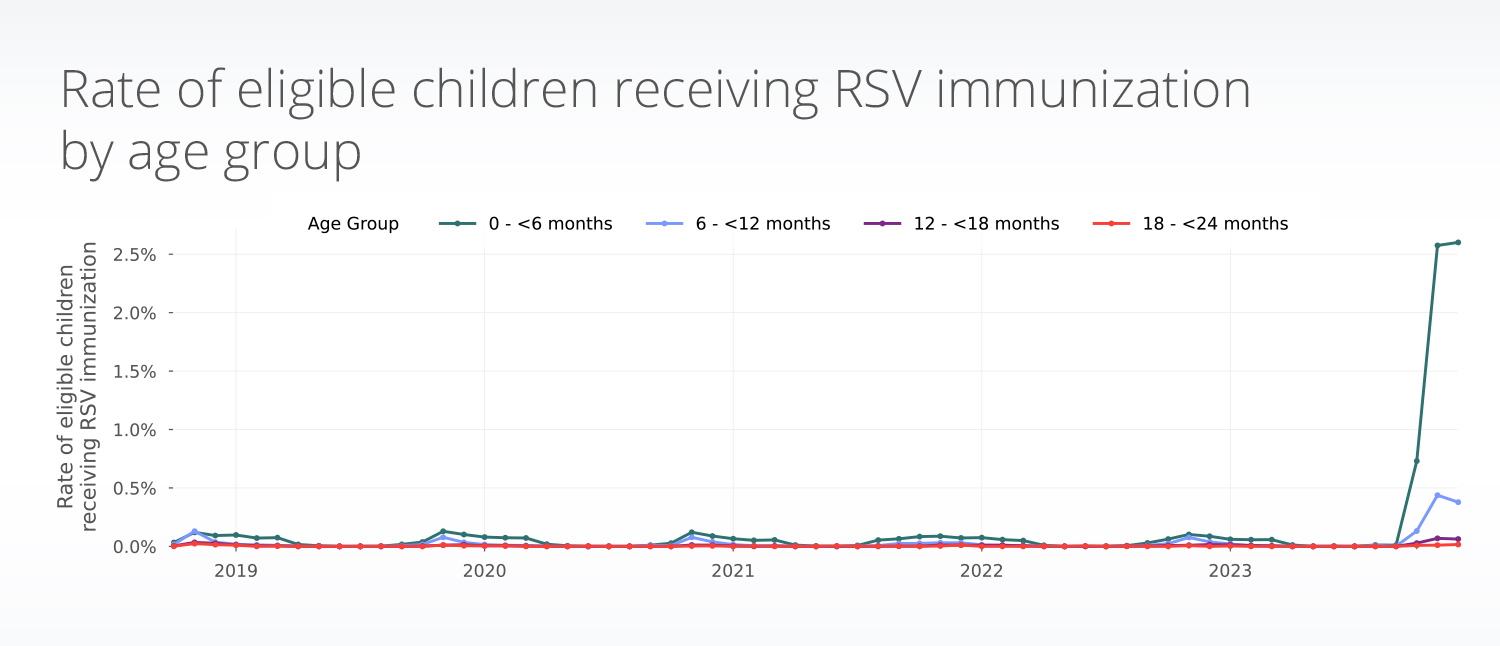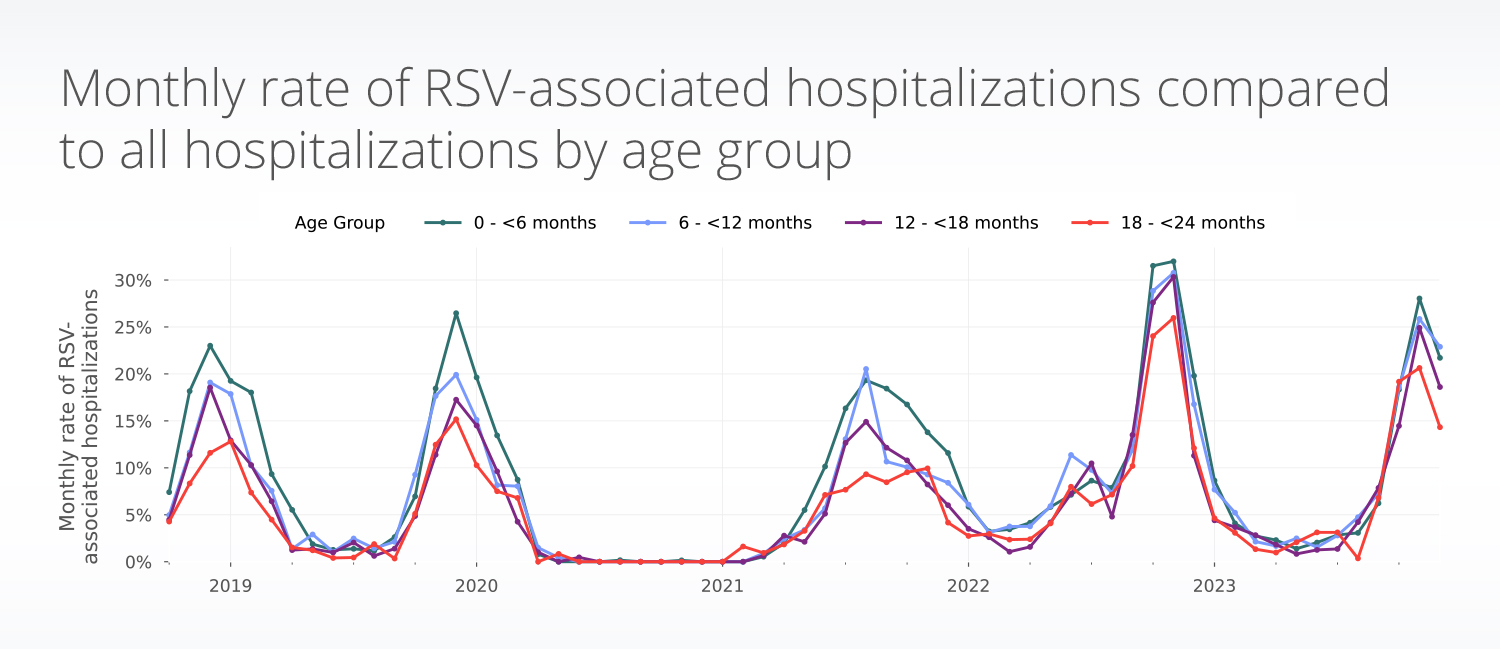- Truveta Research explored the rates of pediatric RSV immunizations and pediatric RSV-associated hospitalizations for children under the age of two.
- Of the 1,872,292 children under age two who were eligible to receive an RSV immunization, 3.7% of the eligible population have received an immunization since it was approved in July 2023.
- Of the 93,228 children under age two who were hospitalized (for any reason) between October 2018 and December 2023, 13.88% (12,939) were RSV-associated hospitalizations. Although infants aged 0-6 months comprise the largest percent of hospitalizations, more recently, older infants have increasingly been hospitalized; RSV-associated hospitalizations for the 6–12-month age group increased from 20.0% of the hospitalized population in the 2018/2019 season to 22.8% of the population in the current 2023/2024 season.
The infectious respiratory virus known as respiratory syncytial virus (RSV) usually circulates from October to February. The coronavirus pandemic affected the seasonality of RSV (likely due to the increased precautions against infection), resulting in a non-existent 2021 season and an earlier and prolonged 2022 season.
In mid-2023, the FDA approved RSV immunizations for people over age 60, children under 24 months of age, and pregnant women to prevent illness in infants. Given the recency of the availability of these immunizations, there is a lack of data to understand how many people, but specifically infants have received them – either while still in utero (via the immunization for pregnant women) or following birth (the immunization approved for children under 24 months of age). In addition, despite the rise in pediatric RSV infections, there are little data available to understand the age and time-related patterns of RSV-associated pediatric hospitalizations.
To offer insight about the uptake of the new RSV immunizations and RSV-associated hospitalizations for children under 24 months of age, Truveta Research has created a pre-print exploring these trends. Because Truveta Data provides the most complete, timely, and clean de-identified EHR data from more than 30 health systems providing 18% of daily care in the US, Truveta Research shows the latest trends in both pediatric RSV immunizations and RSV-associated hospitalizations from October 2018 to December 2023.
This blog provides a snapshot of the key findings in the pre-print. For the full analysis – inclusive of methodology, all findings, discussion, and limitations – you can view the complete findings on MedRxiv.
Key findings: Pediatric RSV immunization trends
Of the 1,872,292 children under age two who were eligible to receive an RSV immunization, 3.7% of the eligible population have received an immunization since it was approved in July 2023. The highest rates of immunization occurred in the youngest age groups:
- 0-6 months: 4.9%
- 6-12 months: 1.9%
- 12-18 months: 0.6%
- 18-24 months: 0.2%
Most RSV immunizations occurred between October and December of 2023.

Key findings: Pediatric RSV-associated hospitalization trends
Within the population under two who was hospitalized for any reason between October 2018 and December 2023, 13.9% experienced RSV-associated hospitalizations.
The seasonality of RSV-associated hospitalizations was impacted by the pandemic.
- 2018/2019 and 2019/2020 seasons: In the two seasons we studied before the pandemic, hospitalizations associated with RSV started to rise in November and subsided by March/April of the following year.
- 2020/2021 season: The rate of RSV-associated hospitalizations was uncommonly low during the usual peak periods (October – March), rather, there were unusual increased rates in July 2021, towards the end of the respiratory virus season.
- 2022/2023 season: There were both earlier (increased rates in September) and higher RSV-associated hospitalizations compared to prior years (78.5% increase in the 2020 and 2022 seasonal peaks).
- 2023/2024 season: The rates began to rise in October, reaching the highest point of the current season at 26.2% in November 2023.
Although infants aged 0-6 months comprise the largest percent of hospitalizations, more recently, the percentage of older children with RSV-associated hospitalizations has increased.
- 6–12-month age group: Hospitalizations associated with RSV increased from 20.0% in the 2018/2019 season to 22.8% of the hospitalized population in the current 2023/2024 season.
- 12–18-month age group: Hospitalizations associated with RSV increased from 14.1% in the 2018/2019 season to 15.6% of the hospitalized population in the current 2023/2024 season.
- 18-24-month-old age group: Hospitalizations associated with RSV increased from 7.9% in the 2018/2019 season to 9.9% of the hospitalized population in the current 2023/2024 season.
For a look at all respiratory virus-associated hospitalizations through December 2023, you can read the Truveta Research summary blog or view the full monitoring report findings on MedRxiv.

Discussion
This study is one of the first to show the low rate of RSV immunization – less than 4% of the eligible pediatric population since approval in July 2023. One factor that may be contributing to the low rates of immunization could be a potential lack of availability of the immunizations. However, with seasonal pediatric RSV trends – particularly in hospitalizations – higher in recent years, increased pediatric immunizations are important.
You can find more details in the full report on MedRxiv.
